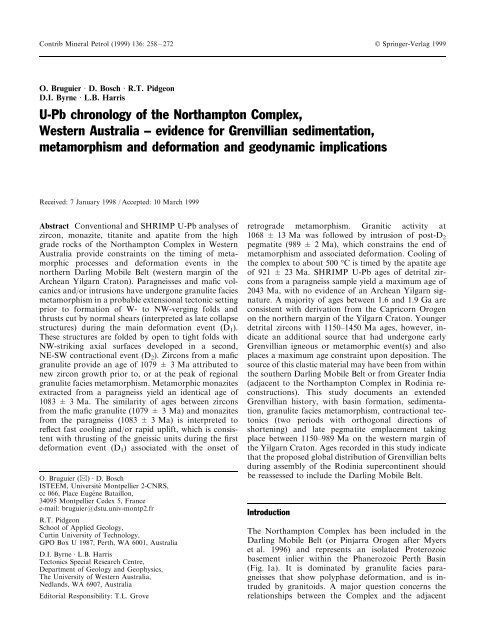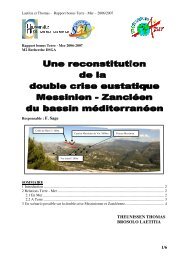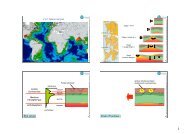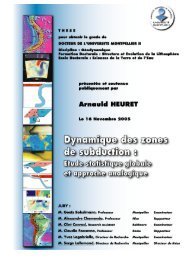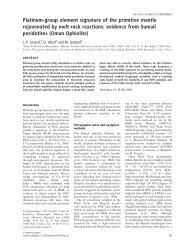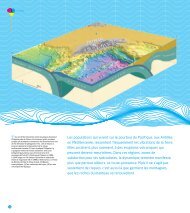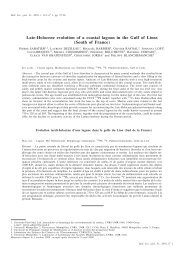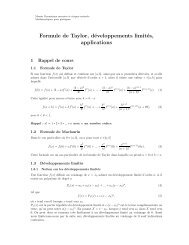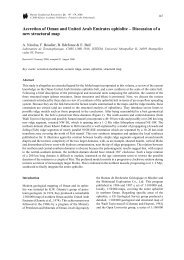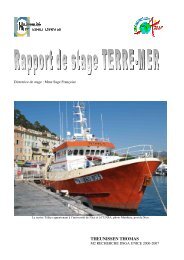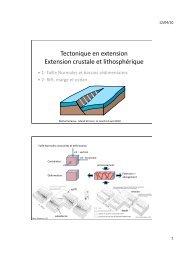Géochronologie U-Pb par ablation laser et ICP-MS (LA-ICP-MS ...
Géochronologie U-Pb par ablation laser et ICP-MS (LA-ICP-MS ...
Géochronologie U-Pb par ablation laser et ICP-MS (LA-ICP-MS ...
You also want an ePaper? Increase the reach of your titles
YUMPU automatically turns print PDFs into web optimized ePapers that Google loves.
Contrib Mineral P<strong>et</strong>rol (1999) 136: 258 – 272 Ó Springer-Verlag 1999<br />
O. Bruguier á D. Bosch á R.T. Pidgeon<br />
D.I. Byrne á L.B. Harris<br />
U-<strong>Pb</strong> chronology of the Northampton Complex,<br />
Western Australia ± evidence for Grenvillian sedimentation,<br />
m<strong>et</strong>amorphism and deformation and geodynamic implications<br />
Received: 7 January 1998 / Accepted: 10 March 1999<br />
Abstract Conventional and SHRIMP U-<strong>Pb</strong> analyses of<br />
zircon, monazite, titanite and apatite from the high<br />
grade rocks of the Northampton Complex in Western<br />
Australia provide constraints on the timing of m<strong>et</strong>amorphic<br />
processes and deformation events in the<br />
northern Darling Mobile Belt (western margin of the<br />
Archean Yilgarn Craton). Paragneisses and mafic volcanics<br />
and/or intrusions have undergone granulite facies<br />
m<strong>et</strong>amorphism in a probable extensional tectonic s<strong>et</strong>ting<br />
prior to formation of W- to NW-verging folds and<br />
thrusts cut by normal shears (interpr<strong>et</strong>ed as late collapse<br />
structures) during the main deformation event (D 1 ).<br />
These structures are folded by open to tight folds with<br />
NW-striking axial surfaces developed in a second,<br />
NE-SW contractional event (D 2 ). Zircons from a mafic<br />
granulite provide an age of 1079 ± 3 Ma attributed to<br />
new zircon growth prior to, or at the peak of regional<br />
granulite facies m<strong>et</strong>amorphism. M<strong>et</strong>amorphic monazites<br />
extracted from a <strong>par</strong>agneiss yield an identical age of<br />
1083 ± 3 Ma. The similarity of ages b<strong>et</strong>ween zircons<br />
from the mafic granulite (1079 ± 3 Ma) and monazites<br />
from the <strong>par</strong>agneiss (1083 ± 3 Ma) is interpr<strong>et</strong>ed to<br />
reflect fast cooling and/or rapid uplift, which is consistent<br />
with thrusting of the gneissic units during the first<br />
deformation event (D 1 ) associated with the ons<strong>et</strong> of<br />
O. Bruguier (&) á D. Bosch<br />
ISTEEM, Universite´ Montpellier 2-CNRS,<br />
cc 066, Place Eugène Bataillon,<br />
34095 Montpellier Cedex 5, France<br />
e-mail: bruguier@dstu.univ-montp2.fr<br />
R.T. Pidgeon<br />
School of Applied Geology,<br />
Curtin University of Technology,<br />
GPO Box U 1987, Perth, WA 6001, Australia<br />
D.I. Byrne á L.B. Harris<br />
Tectonics Special Research Centre,<br />
De<strong>par</strong>tment of Geology and Geophysics,<br />
The University of Western Australia,<br />
Nedlands, WA 6907, Australia<br />
Editorial Responsibility: T.L. Grove<br />
r<strong>et</strong>rograde m<strong>et</strong>amorphism. Granitic activity at<br />
1068 ± 13 Ma was followed by intrusion of post-D 2<br />
pegmatite (989 ± 2 Ma), which constrains the end of<br />
m<strong>et</strong>amorphism and associated deformation. Cooling of<br />
the complex to about 500 °C is timed by the apatite age<br />
of 921 ± 23 Ma. SHRIMP U-<strong>Pb</strong> ages of d<strong>et</strong>rital zircons<br />
from a <strong>par</strong>agneiss sample yield a maximum age of<br />
2043 Ma, with no evidence of an Archean Yilgarn signature.<br />
A majority of ages b<strong>et</strong>ween 1.6 and 1.9 Ga are<br />
consistent with derivation from the Capricorn Orogen<br />
on the northern margin of the Yilgarn Craton. Younger<br />
d<strong>et</strong>rital zircons with 1150–1450 Ma ages, however, indicate<br />
an additional source that had undergone early<br />
Grenvillian igneous or m<strong>et</strong>amorphic event(s) and also<br />
places a maximum age constraint upon deposition. The<br />
source of this clastic material may have been from within<br />
the southern Darling Mobile Belt or from Greater India<br />
(adjacent to the Northampton Complex in Rodinia reconstructions).<br />
This study documents an extended<br />
Grenvillian history, with basin formation, sedimentation,<br />
granulite facies m<strong>et</strong>amorphism, contractional tectonics<br />
(two periods with orthogonal directions of<br />
shortening) and late pegmatite emplacement taking<br />
place b<strong>et</strong>ween 1150–989 Ma on the western margin of<br />
the Yilgarn Craton. Ages recorded in this study indicate<br />
that the proposed global distribution of Grenvillian belts<br />
during assembly of the Rodinia supercontinent should<br />
be reassessed to include the Darling Mobile Belt.<br />
Introduction<br />
The Northampton Complex has been included in the<br />
Darling Mobile Belt (or Pinjarra Orogen after Myers<br />
<strong>et</strong> al. 1996) and represents an isolated Proterozoic<br />
basement inlier within the Phanerozoic Perth Basin<br />
(Fig. 1a). It is dominated by granulite facies <strong>par</strong>agneisses<br />
that show polyphase deformation, and is intruded<br />
by granitoids. A major question concerns the<br />
relationships b<strong>et</strong>ween the Complex and the adjacent


